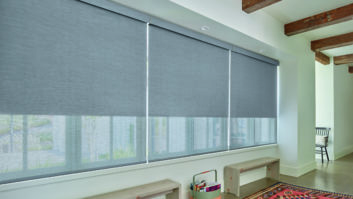
If you thought that all of the program evaluation forms that youve filled out at past CEDIA EXPOs have been tossed in the trash, think again. In assessing the curriculum to be offered at this years convention, the volunteer Content Action Team looked at these actual forms and took their suggestions to heart. In September, CEDIA is launching Learning Labs, boot-camp style hands-on sessions that tie into six electronic systems technician (EST) courses.
This years EST Content Action Team chair Dave Shaffer, CEO of Green Light Technologies, and his committee read through these forms and discovered that the common request was for more hands-on learning opportunities. The committee acknowledged that while technicians often have field experience in areas covered in CEDIA classes, they dont always know why something should be done in a certain way or even completely understand the process it takes to get there. Learning Labs will help fill that void during EXPO 2008, September 3-7 in Denver, Shafer explained.
The labs will allow us to offer industry-accepted best practices to be taught with not only the theory in the classroom, but also the hands-on experience to enforce the theory, he said.
The Boot Camp Model
According to Mike Creeden, 2008 Content Action Team chair and president of M+R Digital Innovations, the committee wanted to bring a Boot Camp style to Denver. Based year-round at CEDIAs Indianapolis headquarters, Boot Camp has been an overwhelming success for the association due to its get-your-hands-dirty approach.

CEDIA’s director of technical training, Jeff Gardner (right), the 2008 content action team chair Mike Creeden, asked Learning Labs planners to determine which course would most effectively tie into a hands-on environment. Video and audio calibrations were the most obvious candidates.While a modified Boot Camp typically makes it way to annual EXPO conventions, its logistically impossible to offer the complete experience on the road. Thats why Creeden and his team of volunteers began looking at what they could take from Boot Camp and apply to other educational sessions at EXPO. The end result is a series of three Learning Labs covering specific areas: cables, connectors, termination and testing; video display calibration; and home theater audio calibration.
Seven courses will have lab work attached for a total of 16 sessions. Courses include Cable & Connector Properties; Electrical and Electronic Test Equipment; Data Cabling Infrastructure & Practices; Video Display Technologies for Installers; Installing Telephone Systems, Infrastructure and Equipment; Audio Set-Up and Calibration; and Video Set-Up and Calibration.
How it Works
At the conclusion of the lecture portion of each Learning Labs course, an instructor will escort class participants to a corresponding lab where they will then be able to practice what they just learned, explained Jeff Gardner, director of technical training for CEDIA. In the cable lab, for example, students will be able to test equipment using various tools. The video lab will comprise 16 flat-panel displays, at which students will practice using test patterns and blue filters. The audio lab will house a full home theater, where students will perform a 5.1 audio set up and verification exercise. Students will use pink noise to make sure loudspeakers are in phase, learning to adjust levels and channels, EQ the system, and equalize each of the channels and testing for optimum speaker response.
Developing the Labs
According to Gardner, the EST content action team had to determine which course would most effectively tie into a Learning Labs environment. Video and audio calibrations were the most obvious candidates for a hands-on learning application, Gardner explained. You could bring a display into a classroom and demonstrate, but its not the same as doing the changes and seeing the results yourself, he said. This way, the first time they are putting this knowledge into use wont be at the customers home.

In developing the Learning Labs, CEDIA sought sponsors who could fund the development of the labs and also serve as true educational partners. CEDIA turned to ADI, because the well-known national distributor has been a long-time education partner of CEDIA, with proven expertise in offering training to its dealers. Rather than sponsoring one or two of the labs, ADI offered to sponsor all three.
Teaming up with CEDIA to provide the Learning Labs was a natural fit, said R.J. Hirshkind, ADIs senior product manager for residential and commercial AV, telephony, and central vacuum. ADI is focused on educating our dealers by giving them hands-on training with technology, he said. CEDIA is a premier organization in this space to help with the education of the dealers. Our goals are synergistic.
ADIs Contribution
After receiving some general guidance on requirements by CEDIA, ADI has been given the flexibility to design the Learning Labs as a truly educational environment that can also be visited by non-students during the times when the labs are not in session.
Gardner explained that through ADIs design, visitors to the labs will be exposed to other disciplines, including lighting control and security. In the video lab, people will be free to browse two rows of displays. Along the perimeter of the room will be a Media Center, projectors and screens and also a Blu-ray player with a 1080p display. It will be a combination school and museum, he said.
ADIs national training manager, Michael Masten, noted that products from a variety of manufacturers have been chosen to show versatility in how they can be incorporated into different system designs. Were pulling the rooms apart piece by piece to see how we can maximize a true exposure to the multiple senses, he said.
For example, the connectivity lab will contain a series of structured wiring panels along with a series of products that attach to them. There are so many submarkets that residential structured wiring can include, such as telephone, intercom, distributed audio, home theater, lighting control, home automation, etc. The structured wiring panel can get in the middle of it all. Each of those subsystems can tie back to that one panel, said Doug Hoerle, ADIs director of systems business. Its similar to your houses wiring, where all of the homes electrical circuits report back to the breaker box. The subsystems dont have to integrate with each other to wire to the structured cabling panel.
The bottom line, according to Masten, is that in this market, dealers need more tools in their toolbox. As were seeing the builder market dry up, dealers with more opportunities for these subsystems can win new business, and those only doing one or two systems may not be around in a year, he said. This gives the dealers more opportunity to compete in the future.
Karen Sussman is a freelance writer in Carmel, Indiana.






